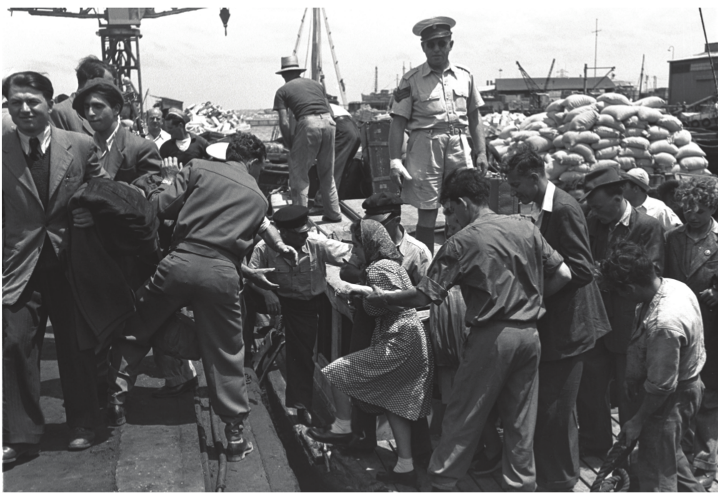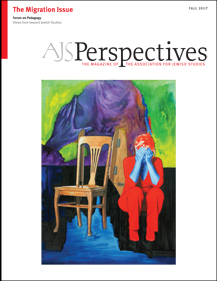
The popularity of the "new Jews" metaphor, however, masks a central dimension of Jewish history in the second half of the twentieth century. In the wake of the Holocaust, the exceptionality of Jewish "pariahdom" gave way to a normalization of Jewish international migration. To be sure, the Exodus affair of July and August 1947 put on full display the drama of "humanity at sea." Indeed, until the creation of the State of Israel, the approximately 200,000 Holocaust survivors in the displaced persons camps of occupied Germany endured a world closed off to large numbers of Jewish refugees. With its restrictive stipulations, the Displaced Persons Act passed in June 1948 by the United States Congress favored anticommunist Poles, Ukrainians, and former nationals of the Baltic states over Jewish immigrants. By 1950, however, most Jewish displaced persons had left for Israel, with others going to the United States (where the revised DP Act of 1950 lifted previous restrictions), Australia, Canada, and Latin America. For American and European policy makers, the swift stabilization of the displaced persons crisis in postwar Germany through the resettlement of "freedom-loving" refugees across the world aimed to countenance the spread of communism. Enabled in part by the International Refugee Organization (the predecessor of UNHCR), the emigration of Holocaust survivors from central Europe to Israel was also part of a broader "redistribution" of displaced Europeans in the early Cold War period. "If we are saved we feel humiliated, and if we are helped we feel downgraded," wrote a gloomy Arendt in 1943, describing the travails of German Jewish exiles like herself. Yet despite the hardships of uprooting and new beginnings in Israel or the New World, this tragic vision of solitude and alienation was less applicable to post-1948 European Jewish migrants.
The recognition of "persecution" as a key determinant in the definition of refugees in international law also contributed to a qualitative upgrade in the status of Jewish (but even more so, in non-Jewish) asylum seekers. The still-effective 1951 Geneva Convention on Refugees did not make any direct references to the Holocaust but stipulated that a "wellfounded fear of being persecuted for reasons of race, religion, nationality" constitutes grounds for protection and asylum. That Israeli legal scholars and diplomats were influential in the passing of the convention—as well as in the adoption of the 1954 Convention on Statelessness—was not innocuous. Although the birth of Israel created a massive Palestinian refugee problem, the new state rapidly became a model for the wide-scale absorption and integration of stateless "ingatherers." The experience of Jewish statelessness indeed loomed large behind the reevaluation of "citizenship" as a basic human right in postwar legal and political thought. If Arendt used the Jewish pariah negatively to emphasize the frailty of liberal citizenship and the "decline of the rights of man," others, such as Chief Justice Earl Warren in 1958, positively asserted that "citizenship is man's basic right, for it is nothing less than the right to have rights." Revealingly, it was the case brought in front of the Supreme Court by the Polish-born Jew Beys Afroyim in 1967 that led to the prohibition of forcible denaturalization in the United States, thus consecrating the advent of a "sovereign citizen" endowed with inviolable citizenship.
Jewish refugees from North Africa and the Middle East were unaffected by these new guarantees. In Iraq between 1950 and 1952, the forced departure of nearly 130,000 Jews to Israel was accompanied by collective deprivation of citizenship in addition to material dispossession, a pattern repeated in 1956 in Egypt. The approximately 800,000 Jews who, under various degrees of coercion, left Arab or Muslim countries after 1948 symbolized indeed the persistence of Jewish vulnerability: the Mizrahi replaced the German Jew in this new episode of destitution. But the experiences of Jewish refugees from Arab lands were ultimately different. In several cases, such as Yemen, Iraq, or Morocco, the State of Israel entered in secret negotiations with Arab regimes to facilitate the safe departure of Jews. Their abrupt abandonment of ancestral places of residence was undoubtedly traumatic, as was life in transit camps such as Grand Arénas near Marseilles, where Israeli doctors, welfare workers, and immigration officials placed Moroccan Jews under strict humanitarian governance. Yet the Law of Return passed by the Knesset in 1950 ensured the automatic reintegration of all Jewish refugees into the realm of citizenship. In other host countries, such as France and England, denaturalized Jews from Egypt easily obtained citizenship in the favorable postwar context of open-door immigration.
Persecuted or endangered Jews in Communist Eastern Europe faced different hurdles. In Romania, Nicolae Ceausescu allowed more than 100,000 Jews to emigrate in return for Israeli economic aid, merchandise, or cash. But fierce "anti- Zionist" campaigns in Poland forced small numbers of Jews to leave in the late 1950s and again in 1968. By then, however, East European Jews and Soviet refuseniks authorized to leave, as well as Iranian Jews who fled the new Islamic regime in 1979, transited in Vienna or Rome, where visas to Israel, the United States, or Western Europe awaited them. Potent symbols of human rights violations at the dawn of the 1970s, refuseniks elicited transnational advocacy campaigns unthinkable in 1938, when the Jewish exodus from Hitler's Reich reached its apex. In the United States, the Jackson- Vanik Amendment of 1974 put economic pressure on the Soviet Union in order to let Jews depart to Israel. As international human rights "exploded" in the West in the 1970s, so did expressions of solidarity with Jewish dissidents and emigrants from the Soviet Union. In the early 1990s, a century after their forefathers fled poverty and oppression in the Pale of Settlement to reach the goldene medinah, one million Jews from the former Soviet Union settled in Israel thanks to unprecedented American loan guarantees. Others directly immigrated (or re-emigrated from Israel) to the United States on special refugee visas issued under the Lautenberg Amendment of 1989. Despite the huge challenges presented by reunification, the Federal Republic of Germany similarly provided generous asylum to ex-Soviet Jews.



 Gerard Daniel Cohen is Eurias Fellow at the Institute für die Wissenschaften vom Menschen, Vienna and Samuel W. and Goldye Marian Spain Associate Professor in Jewish Studies at Rice University. He is the author of In War's Wake: Europe's Displaced Persons in the Postwar Order (Oxford University Press, 2012) and numerous articles on Jewish refugees, human rights, and humanitarianism in the twentieth century. He is currently completing a book on the uses and misuses of "philosemitism" in Europe from 1945 to the present.
Gerard Daniel Cohen is Eurias Fellow at the Institute für die Wissenschaften vom Menschen, Vienna and Samuel W. and Goldye Marian Spain Associate Professor in Jewish Studies at Rice University. He is the author of In War's Wake: Europe's Displaced Persons in the Postwar Order (Oxford University Press, 2012) and numerous articles on Jewish refugees, human rights, and humanitarianism in the twentieth century. He is currently completing a book on the uses and misuses of "philosemitism" in Europe from 1945 to the present.